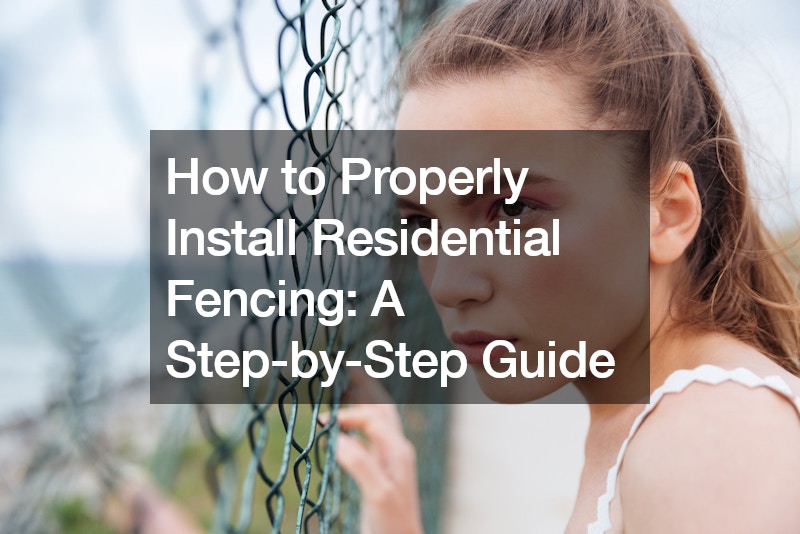
A well-constructed fence adds beauty, privacy, and security to your US property. While professional installation offers peace of mind, the allure of a DIY project beckons for many homeowners. This comprehensive guide empowers you to navigate the process of installing a residential fence, transforming your backyard into a private oasis.
Important Note: Before embarking on any fence installation project, consult your local building department to obtain any necessary permits and ensure your chosen fence design adheres to all zoning regulations. Understanding property lines and potential underground utilities is also crucial.
For complex fence designs or challenging terrains, consider seeking assistance from a licensed fencing contractor.
Planning Your Residential Fence Installation: A Sturdy Foundation Choosing the Right Fence Type: Consider factors like desired privacy level, maintenance requirements, budget, and aesthetic preferences. Popular options include wood, vinyl, chain link, and wrought iron. Design and Materials: Finalize your fence design, including height, length, and gate placement. Purchase the necessary materials like fence posts, panels, fasteners, concrete mix, gravel (for post holes), and leveling tools. Step-by-Step Guide to Installing a Residential Fence: 1. Marking the Fence Line:
Clear the Area: Remove any existing vegetation, debris, or obstacles from the planned fence line. String and Stakes: Use string and stakes to mark the exact path of your fence. Double-check measurements to ensure straight lines and accurate post-placement. Call Before You Dig: Before digging any post holes, contact your local utility locating service to identify and mark any underground utility lines to avoid accidental damage. 2. Digging Post Holes:
Post Spacing: Maintain consistent spacing between fence posts as recommended by the manufacturer and your chosen fence material. Typical spacing ranges from 6 to 8 feet. Digging the Holes: Use a post-hole digger or shovel to create holes for each fence post. Ensure the depth is sufficient for proper post stability, typically around 1/3 of the total post height below ground level. 3. Setting the Fence Posts:
Post Leveling: Place each post in its corresponding hole and ensure it’s perfectly plumb (vertical) using a level. Use shims (wedges) to achieve proper alignment. Mixing Concrete: Following the manufacturer’s instructions, mix concrete to create a sturdy base for each post. Securing the Posts: Pour the concrete mix into the post holes, ensuring the posts remain plumb throughout the process. Allow the concrete to cure completely as per the recommended drying time. 4. Installing Fence Panels:
Panel Attachment: Attach the fence panels to the posts according to the manufacturer’s instructions. This might involve screwing, bolting, or using specialized brackets depending on the fence material. Alignment and Leveling: Ensure all fence panels are level and securely fastened to the posts. Maintain consistent spacing between panels for a professional look. 5. Gate Installation (if applicable):
Post Preparation: Install sturdy gate posts using the same method as for fence posts, ensuring proper alignment and stability. Gate Assembly: Assemble the gate hardware following the manufacturer’s instructions. Hang the gate on the posts and adjust hinges for smooth operation. 6. Finishing Touches:
Cleaning Up: Remove any debris, leftover materials, or concrete splatter from the work area. Painting or Staining (optional): If using a wood fence, apply a coat of paint or stain for added protection and aesthetics. 7. Safety Check:
Final Inspection: Conduct a thorough inspection of your newly installed fence. Ensure all posts are secure, panels are firmly attached, and the gate operates smoothly without any obstructions. Additional Considerations for Residential Fence Installation: Underground Utilities: Remember to call before you dig to avoid any potential hazards from underground utility lines. Soil Conditions: For loose or sandy soil, consider using a larger post hole diameter or tamper (a tool used to compact soil) to ensure optimal post stability. Renting Equipment: For large fencing projects, renting a post hole digger or concrete mixer can save time and effort.Conclusion: The Reward of a DIY Fencing Project Installing a residential fence can be a rewarding DIY project, providing a sense of accomplishment and adding value to your property. By following this step-by-step guide, planning meticulously, prioritizing safety, and adhering to local regulations, you can transform your backyard into a secure and beautiful haven. Remember, for complex designs or challenging installations, seekingremember, for complex designs or challenging installations, seeking professional assistance from a licensed fencing contractor is always a wise decision.Additional Tips:
Work with a Partner: Having a helper can be invaluable during tasks like holding posts in place while securing them with concrete, or ensuring proper panel alignment. Watch Online Tutorials: Complement this guide with visual learning by searching online for video tutorials demonstrating fence installation techniques specific to your chosen material. Start Small: For beginners, consider starting with a shorter fence section to gain experience and confidence before tackling a larger project. Beyond the Basics: Advanced Residential Fence Installation Techniques
This guide focuses on a general approach to residential fence installation. For those seeking to explore more intricate designs or materials, here are some advanced techniques to consider:
Concrete Footings: For very tall or heavy fences, especially in areas with harsh weather conditions, using concrete footings below the post holes provides additional stability. This involves creating a wider base of concrete beneath each post for enhanced support. Decorative Fence Toppers: Fence toppers add a stylish finishing touch to your fence. These come in various materials like wood, metal, or vinyl and can be easily installed on top of fence posts. Sloped Terrain: For uneven terrain, post hole depths will need to be adjusted to maintain a consistent fence height. Some fence post designs allow for angled cuts to accommodate slopes.
By understanding your DIY skillset, embracing safety precautions, and leveraging the valuable information provided here, you can confidently embark on your residential fence installation project. The satisfaction of completing a significant home improvement project yourself and the resulting security and beauty it brings to your property will make the effort well worth it.
.


